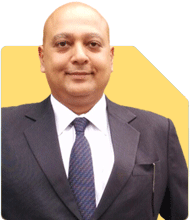Ramalingam Kalirajan |5975 Answers |Ask -Follow
Mutual Funds, Financial Planning Expert - Answered on Jul 15, 2024
He has an MBA in finance from the University of Madras and is a certified financial planner.
He is the director and chief financial planner at Holistic Investment, a Chennai-based firm that offers financial planning and wealth management advice.... more

Hi Mam, Good day I am 46 years old earning about 3 Lakh per month. I am Planning to retire by 54 years. My current assets/ savings are as follows: Properties and plots - 6.5 crores PF, PPF and NPS - 25 Lakhs FD - 50 Lakhs Emergency fund - 8 Lakhs Stocks and Mutual Fund - 25 Lakhs Gold - 90 Lakhs LIC and Tax saver funds - 25 Lakhs Other Investments - 5 Lakhs Apart from this I have a Term insurance of Rs. 1 crore and medical insurance of Rs. 15 Lakh. I have my own house so need to pay any rent. Currently I am getting an additional income of 65000 with my asset/ saving through rent and interest. I want to increase my additional income to Rs. 1 Lakh/month. What is the best way to increase my additional income of Rs. 35000 in next 8 years to have a peaceful retirement. Thanks for your advice in advance. Regards, Krishna Prasad
Good day! Thank you for sharing the details of your financial landscape. Your disciplined approach towards saving and investing is commendable and sets a strong foundation for a secure retirement. Let's delve into the specifics of how you can enhance your additional income by Rs. 35,000 per month over the next eight years to achieve your goal of a peaceful retirement by age 54.
Reviewing Your Asset Allocation
Properties and Plots: Rs. 6.5 Crores
Real estate constitutes a significant portion of your portfolio. While this is a stable and appreciating asset, it isn't highly liquid. Therefore, it's crucial to focus on other investments for increasing your monthly income.
Provident Fund, Public Provident Fund, and National Pension System: Rs. 25 Lakhs
These are excellent for long-term growth and tax benefits. However, their contribution to your monthly income is minimal.
Fixed Deposits: Rs. 50 Lakhs
Fixed deposits provide safety but typically offer lower returns compared to other investment avenues. We'll explore better alternatives while keeping a portion for safety.
Emergency Fund: Rs. 8 Lakhs
Maintaining an emergency fund is wise. This should remain untouched for unforeseen expenses.
Stocks and Mutual Funds: Rs. 25 Lakhs
This portion of your portfolio can generate higher returns and income through dividends and capital gains.
Gold: Rs. 90 Lakhs
Gold is a good hedge against inflation but doesn’t generate monthly income. We should consider how to optimize its role in your portfolio.
LIC and Tax Saver Funds: Rs. 25 Lakhs
These offer moderate returns and tax benefits. Reviewing these investments for potential improvement in returns could be beneficial.
Other Investments: Rs. 5 Lakhs
We can analyze these for better alignment with your income goals.
Term Insurance: Rs. 1 Crore and Medical Insurance: Rs. 15 Lakhs
These policies provide necessary protection and should be retained.
Enhancing Monthly Income
To achieve an additional Rs. 35,000 per month, let's consider various strategies. Each has its own risk and return profile, which we'll assess in detail.
Systematic Withdrawal Plan (SWP)
Systematic Withdrawal Plans from mutual funds allow you to withdraw a fixed amount regularly. This strategy helps in generating a steady income stream while your principal continues to grow.
Advantages:
Potential for higher returns than fixed deposits.
Flexibility in withdrawal amounts.
Considerations:
Market volatility can affect the fund value.
Requires careful selection of funds with stable performance.
Dividend-Paying Stocks
Investing in high-dividend-paying stocks can provide a regular income stream. These companies distribute a portion of their earnings to shareholders regularly.
Advantages:
Potential for capital appreciation along with dividend income.
Dividends can provide tax-efficient income.
Considerations:
Stock prices can be volatile.
Requires thorough research and selection of reliable companies.
High-Yield Debt Funds
Debt funds with a focus on high-yield bonds can offer better returns than traditional fixed deposits.
Advantages:
Better returns compared to fixed deposits.
Diversification of risk.
Considerations:
Credit risk associated with bonds.
Interest rate risk can affect fund value.
Balanced Advantage Funds
These funds dynamically manage the asset allocation between equity and debt based on market conditions. This can provide growth and income with moderate risk.
Advantages:
Automatic adjustment between equity and debt.
Potential for stable returns with lower risk.
Considerations:
Performance depends on the fund manager's strategy.
May have higher management fees.
Gold Monetization Scheme
If you have idle gold, consider the Gold Monetization Scheme. It offers interest on your gold holdings while keeping the asset intact.
Advantages:
Earn interest on otherwise idle gold.
Retain gold's value.
Considerations:
Limited liquidity compared to selling gold.
Interest rates may be lower than other investments.
Regularly Review and Rebalance Your Portfolio
It's crucial to periodically review and rebalance your portfolio to ensure it aligns with your financial goals and market conditions.
Steps:
Review asset performance semi-annually or annually.
Rebalance to maintain desired asset allocation.
Adjust investments based on changing goals or market outlook.
Tax Efficiency
Maximizing tax efficiency can enhance your net income.
Strategies:
Utilize tax-free bonds for tax-efficient interest income.
Opt for tax-efficient mutual fund investments.
Leverage tax deductions and exemptions available under the Income Tax Act.
Exploring SIP in Mutual Funds
Systematic Investment Plans (SIPs) in mutual funds allow you to invest a fixed amount regularly, building a substantial corpus over time.
Advantages:
Disciplined investment approach.
Rupee cost averaging mitigates market volatility.
Considerations:
Requires long-term commitment for best results.
Market risk associated with equity mutual funds.
Leveraging Professional Guidance
Working with a Certified Financial Planner can provide personalized advice tailored to your unique situation. They can help in optimizing your portfolio, ensuring your investments align with your income and retirement goals.
Benefits:
Expert analysis and recommendations.
Regular monitoring and adjustment of your financial plan.
Comprehensive approach to financial planning.
Diversification
Diversification across asset classes reduces risk and enhances potential returns.
Approach:
Balance investments between equity, debt, and alternative assets.
Avoid over-concentration in any single asset class.
Regularly review and adjust diversification strategy.
Final Insights
Krishna, your financial discipline has set a strong foundation for your retirement. By optimizing your existing portfolio and exploring new investment avenues, you can achieve your goal of increasing your additional income to Rs. 1 lakh per month. Focus on diversifying your investments, leveraging professional guidance, and maintaining a regular review schedule. This strategic approach will help you achieve a comfortable and peaceful retirement.
Best Regards,
K. Ramalingam, MBA, CFP,
Chief Financial Planner,
www.holisticinvestment.in
9 Crore Asset can easily become 10 crores in 8 years.
Increase SIP Contributions: Allocate more to diversified mutual funds for higher returns.
Regular Portfolio Review: Adjust based on performance and market conditions.
Professional Guidance: Consult a Certified Financial Planner (CFP) for tailored advice.
Best Regards,
K. Ramalingam, MBA, CFP,
Chief Financial Planner,
www.holisticinvestment.in
You may like to see similar questions and answers below
Ramalingam Kalirajan |5975 Answers |Ask -Follow
Mutual Funds, Financial Planning Expert - Answered on May 12, 2024
Ramalingam Kalirajan |5975 Answers |Ask -Follow
Mutual Funds, Financial Planning Expert - Answered on Jul 19, 2024
Ramalingam Kalirajan |5975 Answers |Ask -Follow
Mutual Funds, Financial Planning Expert - Answered on Jun 22, 2024
Ramalingam Kalirajan |5975 Answers |Ask -Follow
Mutual Funds, Financial Planning Expert - Answered on Jun 23, 2024
Ramalingam Kalirajan |5975 Answers |Ask -Follow
Mutual Funds, Financial Planning Expert - Answered on Aug 22, 2024
Ramalingam Kalirajan |5975 Answers |Ask -Follow
Mutual Funds, Financial Planning Expert - Answered on Aug 22, 2024
Ramalingam Kalirajan |5975 Answers |Ask -Follow
Mutual Funds, Financial Planning Expert - Answered on Aug 22, 2024
Ramalingam Kalirajan |5975 Answers |Ask -Follow
Mutual Funds, Financial Planning Expert - Answered on Aug 22, 2024
Ramalingam Kalirajan |5975 Answers |Ask -Follow
Mutual Funds, Financial Planning Expert - Answered on Aug 22, 2024
Ramalingam Kalirajan |5975 Answers |Ask -Follow
Mutual Funds, Financial Planning Expert - Answered on Aug 22, 2024
Ramalingam Kalirajan |5975 Answers |Ask -Follow
Mutual Funds, Financial Planning Expert - Answered on Aug 22, 2024
Ramalingam Kalirajan |5975 Answers |Ask -Follow
Mutual Funds, Financial Planning Expert - Answered on Aug 22, 2024
Sushil Sukhwani |500 Answers |Ask -Follow
Study Abroad Expert - Answered on Aug 22, 2024
Ramalingam Kalirajan |5975 Answers |Ask -Follow
Mutual Funds, Financial Planning Expert - Answered on Aug 22, 2024


















